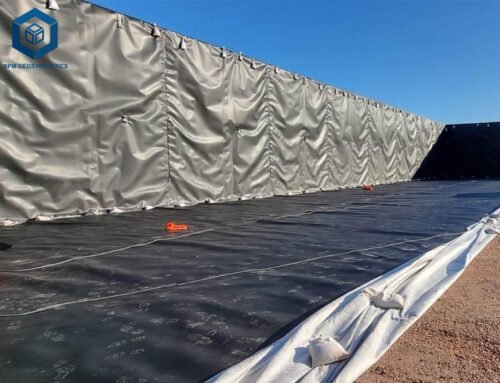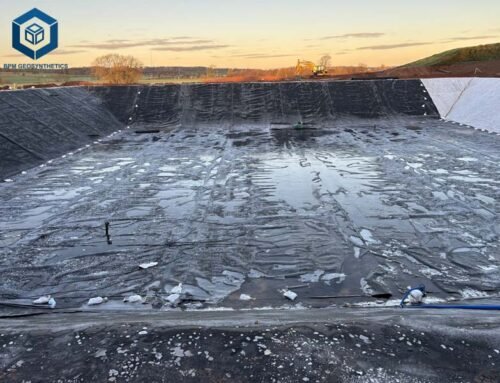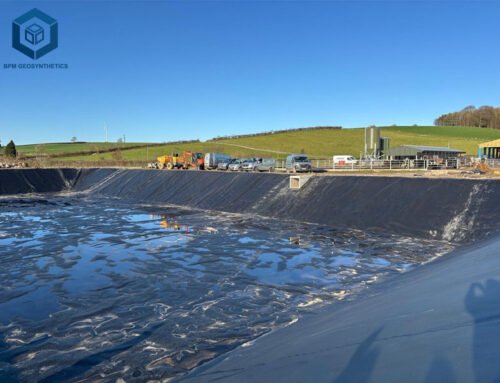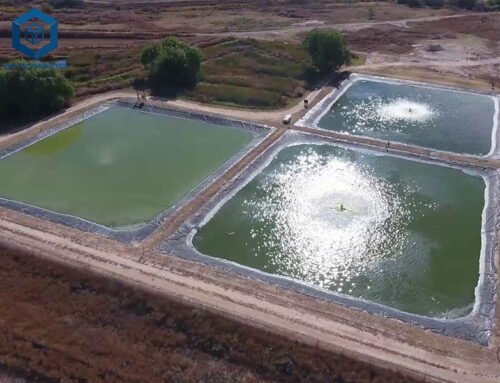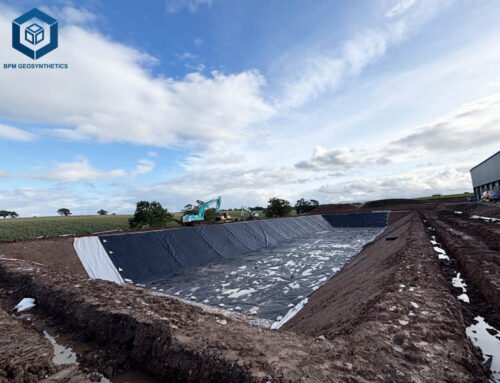In the intricate world of geosynthetics, geomembranes serve as indispensable barriers, preventing the migration of liquids and gases in a vast array of civil engineering and environmental applications. From the foundational layers of a landfill to the serene surface of an ornamental pond, these impermeable liners are critical to ensuring the integrity, safety, and longevity of numerous projects. However, the efficacy of a geomembrane system hinges profoundly on the material chosen, as different polymers exhibit distinct strengths and weaknesses that align with specific project requirements.
Among the most prevalent geomembrane materials are LLDPE and PVC Geomembrane. While both are widely used for containment, they possess unique molecular structures, mechanical properties, chemical resistances, and installation characteristics that differentiate their suitability for various applications. This detailed guide aims to provide engineers, project managers, and environmental professionals with a profound understanding of these differences, allowing for informed decision-making that optimizes performance, minimizes risk, and ensures long-term project success.
1. What are Geomembranes?
Before diving into the specifics of LLDPE and PVC, it’s crucial to grasp the fundamental role of geomembranes. These synthetic barriers are primarily used to contain liquids (such as water, wastewater, or hazardous chemicals) and gases (like methane or radon), prevent their escape into the surrounding environment, or conversely, prevent external contaminants from entering a contained area. Their applications span industries such as:
- Environmental Protection:Landfill liners, caps, and covers; hazardous waste containment.
- Water Management:Pond liners (irrigation, decorative, aquaculture), reservoirs, canals, dams.
- Mining:Heap leach pads, tailings impoundments, process solution ponds.
- Industrial Applications:Secondary containment for storage tanks, wastewater treatment lagoons.
- Civil Infrastructure:Tunnel lining, road base protection, architectural water features.
The selection of the appropriate geomembrane material is a critical engineering decision, influenced by factors such as the nature of the contained substance, site conditions, anticipated stresses, desired lifespan, and budgetary constraints.
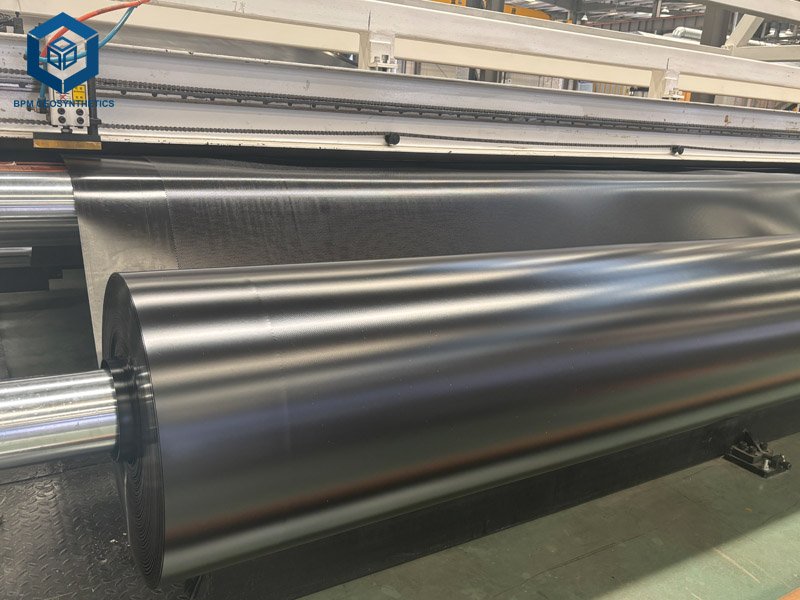
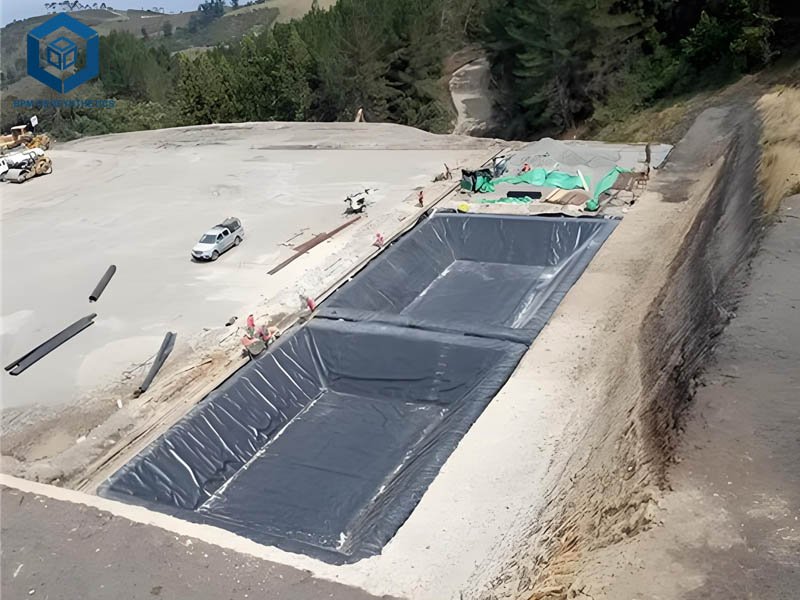
2. LLDPE Geomembrane: The Flexible Powerhouse
Linear Low-Density Polyethylene (LLDPE) geomembrane is a highly flexible, thermoplastic sheeting material derived from polyethylene resin. Its distinctive molecular structure, characterized by numerous short, branching chains, differentiates it from High-Density Polyethylene (HDPE), which has a more crystalline and rigid structure. This branching imparts LLDPE with exceptional flexibility, elongation, and resistance to stress cracking, making it a preferred choice for dynamic environments and projects requiring adaptable liners.
What is LLDPE Geomembrane? Understanding Linear Low-Density Polyethylene’s Unique Molecular Structure and Properties
LLDPE is produced through a low-pressure polymerization process. The controlled introduction of alpha-olefin co-monomers during polymerization leads to the formation of short-chain branches along the main polyethylene backbone. These branches prevent the polymer chains from packing tightly together, resulting in a lower density and a less crystalline, more amorphous structure compared to HDPE. This amorphous nature is the root of LLDPE’s remarkable flexibility, allowing it to stretch significantly without permanent deformation and offering superior conformability to uneven subgrades.
Key Properties and Specifications of LLDPE Geomembrane: Minimal Exposure, Maximum Impact
The performance characteristics of LLDPE geomembranes are rigorously tested and documented according to international standards, primarily those established by the Geosynthetic Research Institute (GRI), such as GRI-GM17 for LLDPE geomembranes. These specifications provide a benchmark for quality and performance.
Density:
Typical LLDPE geomembranes possess a density ranging from 915 to 0.925 g/cm³ (ASTM D792). This relatively lower density, compared to HDPE (≥0.941 g/cm³), directly contributes to its enhanced flexibility.
Tensile Strength at Break (ASTM D6693):
LLDPE exhibits impressive tensile strength, typically ranging from 20 MPa to 40 MPa for smooth samples, and often higher for textured variations. This indicates its robust resistance to pulling forces.
Elongation at Break (ASTM D6693):
This is where LLDPE truly excels. Its elongation at break commonly ranges from 700% to 800%, and in some formulations, can exceed 1000%. This extreme ductility allows LLDPE to accommodate substantial differential settlement, ground movement, and irregular subgrade conditions without tearing or fracturing. For instance, a 1-meter section could theoretically stretch to 8 meters before breaking.
Tear Resistance (ASTM D1004):
LLDPE offers superior tear resistance, with typical values around 150 N (e.g., for a 1.5 mm thick sample). This property is vital in resisting localized damage from sharp aggregate or installation machinery.
Puncture Resistance (ASTM D4833/D5514):
LLDPE geomembranes are highly resistant to puncture. Values often range from 370 N to 500 N (e.g., for 1.5 mm thick material). Its flexibility allows it to deform around sharp objects, distributing the stress over a larger area rather than concentrating it at a single point, thereby reducing the risk of a breach.
Chemical Resistance:
LLDPE generally offers excellent chemical resistance to a broad spectrum of inorganic chemicals, including strong acids (e.g., sulfuric acid), bases (e.g., sodium hydroxide), and salts. It also performs well against many industrial pollutants. However, it’s crucial to consult manufacturers for specific compatibility with organic solvents and hydrocarbons, as these can sometimes cause swelling or degradation.
UV Stability and Weathering:
When adequately formulated with carbon black (typically 2-3% by weight) and various UV stabilizers, LLDPE geomembranes exhibit good long-term resistance to ultraviolet (UV) radiation and weathering. This makes them suitable for exposed applications where the geomembrane will be directly subjected to sunlight, such as canal liners or exposed pond liners. Their ability to withstand prolonged outdoor exposure without significant degradation or loss of effectiveness is a key advantage.
Stress Crack Resistance:
LLDPE has outstanding resistance to environmental stress cracking (ESC), a phenomenon where certain chemicals, combined with sustained stress, can cause brittle fracture in crystalline polymers. LLDPE’s amorphous nature and flexible structure inherently provide superior ESC resistance.
Permeability:
LLDPE geomembranes provide an extremely low hydraulic conductivity, typically in the range of 10−13 to 10−14 cm/sec, ensuring an effective barrier against liquid and gas seepage.
Installation and Seaming: Ease of Deployment and Welding Techniques for LLDPE
LLDPE’s flexibility significantly simplifies installation. It easily drapes and conforms to irregular subgrades, reducing the need for extensive earthwork or meticulous grading. This inherent pliability also minimizes the risk of punctures during deployment and handling.
Field seaming of LLDPE geomembranes is predominantly achieved through thermal fusion welding, specifically using:
- Hot Wedge Welding:This method involves a heated wedge that melts the edges of two geomembrane sheets, which are then pressed together by rollers, creating a strong, homogeneous bond. Dual-track hot wedge welders create two parallel seams with an unbonded air channel between them, allowing for non-destructive air pressure testing of the seam integrity.
- Extrusion Welding:Used for repairs, patch welding, and complex geometries, this method involves extruding molten LLDPE filler material onto the joint, fusing the sheets together.
The weldability of LLDPE is generally considered good, leading to high-quality, durable seams essential for the long-term performance of the liner system.
Cost Analysis: A Comparative Look at LLDPE’s Material and Installation Costs
The initial material cost of LLDPE geomembrane can be comparable to, or sometimes slightly higher than, PVC on a per-square-meter basis, depending on thickness and market conditions. However, the overall project cost can often be reduced due to LLDPE’s ease of installation. Its flexibility allows for faster deployment and less labor-intensive handling, potentially offsetting any higher material cost. Furthermore, its superior durability and longer expected service life can lead to lower long-term maintenance and replacement costs.
Environmental Impact: LLDPE’s Recyclability and Long-Term Sustainability
As a polyethylene product, LLDPE is generally considered more environmentally friendly in terms of recyclability compared to PVC, which contains chlorine and plasticizers. While not always economically viable to recycle all geomembranes at the end of their service life, the potential for recycling LLDPE exists, aligning with broader sustainability goals. Its long lifespan also contributes to environmental benefits by minimizing the need for frequent replacements.
Typical Applications: Where LLDPE Shines in Diverse Engineering Projects
LLDPE geomembranes are the material of choice for applications demanding high flexibility, elongation, and resistance to puncture and stress cracking.
- Landfill Liners and Caps:The primary choice for municipal solid waste (MSW) and hazardous waste landfills due to their ability to accommodate significant differential settlement over time, preventing leachate leakage.
- Mining Heap Leach Pads and Tailings Impoundments:Ideal for challenging mining environments where liners must withstand large settlements, heavy loads, and potentially aggressive chemical solutions (though chemical compatibility must always be verified).
- Large Water Containment Projects:Widely used for large-scale reservoirs, agricultural ponds, and wastewater treatment lagoons where significant ground movement or irregular terrain is present.
- Aquaculture Ponds (Shrimp and Fish Farms):Its non-toxic nature and flexibility make it excellent for fish and shrimp farms, where conformity to pond shapes and robust performance are crucial.
- Secondary Containment:For industrial facilities storing fuels, chemicals, or other hazardous liquids, providing an effective secondary barrier against spills.
Limitations of LLDPE Geomembranes: Understanding Specific Project Constraints
While highly versatile, LLDPE does have some limitations:
- Lower Tensile Strength (Relative to HDPE):While still robust, LLDPE generally has a lower tensile strength and stiffness compared to HDPE, making HDPE preferable in applications requiring extreme rigidity or very high tensile loads.
- Less Resistant to Hydrocarbons:While good with many chemicals, LLDPE can be more susceptible to degradation or swelling when exposed to certain hydrocarbons and oils compared to materials like HDPE or some specialized elastomers.
- Temperature Sensitivity (Extreme):While having a wide operating temperature range, extreme cold can reduce its flexibility, and very high temperatures can affect its mechanical properties, though it typically performs well within standard environmental conditions.
3. PVC Geomembrane: The Proven Performer
Polyvinyl Chloride (PVC) geomembrane is a flexible, thermoplastic sheeting material that has been a cornerstone of the containment industry for over 60 years. Unlike polyethylene, pure PVC resin is rigid. To transform it into a flexible geomembrane suitable for lining applications, significant amounts of plasticizers are added during the manufacturing process, along with heat stabilizers, UV inhibitors, and other additives. These plasticizers are crucial to imparting the desired pliability and rubber-like characteristics to the PVC sheeting.
What is PVC Geomembrane? Exploring the Composition and Characteristics of Polyvinyl Chloride Liners, and Their Role in Various Applications
PVC geomembranes are manufactured by blending PVC resin with a substantial proportion of plasticizers (typically 25-35% by weight), stabilizers (to prevent degradation from heat and UV), and other processing aids. This compounding process results in a flexible, elastomeric sheet material. The plasticizers are organic esters that embed themselves between the PVC polymer chains, increasing the free volume and allowing the chains to move more freely, thus reducing stiffness and increasing flexibility.
Key Properties and Specifications of PVC Geomembrane: Versatility and Durability in Water Management
PVC geomembranes are subject to industry standards like ASTM D7176 for flexible PVC geomembranes, which outline their performance characteristics.
Density:
PVC geomembranes are denser than polyethylene geomembranes, with typical densities ranging from 25 to 1.35 g/cm³ (ASTM D792). This higher density means PVC sheets will be heavier for the same thickness and area.
Tensile Strength at Break (ASTM D6693):
PVC exhibits good tensile strength, often in the range of 13 MPa to 18 MPa. It’s important to note that PVC’s stress-strain curve is different from that of HDPE; PVC undergoes a very large amount of elongation before failure, without a distinct yield point like crystalline polymers.
Elongation at Break (ASTM D6693):
PVC is renowned for its high elongation, typically ranging from 220% to 380% (for 30 mil PVC). While generally lower than LLDPE, this is still significant and allows PVC to conform well to uneven surfaces and absorb moderate differential settlement. Crucially, PVC remains elastic throughout its elongation up to the point of break, meaning much of its deformation is recoverable.
Tear Resistance (ASTM D1004):
PVC offers good tear resistance, typically around 40 N/mm.
Puncture Resistance (ASTM D4833):
PVC geomembranes often demonstrate excellent puncture resistance. Studies have shown that PVC can exceed the puncture resistance of polyethylene geomembranes, even when the PVC is thinner. This is attributed to its amorphous nature, which allows for better stress distribution around localized loads.
Chemical Resistance:
PVC has excellent chemical resistance to a wide range of inorganic chemicals, including most acids, alkalis, salts, and chlorinated solutions. This makes it suitable for many industrial and municipal wastewater applications. However, a significant limitation lies in its compatibility with organic solvents, oils, hydrocarbons, and some petroleum products. These substances can cause plasticizer migration (leaching), leading to the geomembrane becoming stiff, brittle, and eventually cracking over time. Therefore, careful chemical compatibility testing is paramount for specific applications.
UV Stability and Weathering:
While PVC geomembranes are formulated with UV inhibitors, their long-term resistance to direct, prolonged UV exposure is generally considered inferior to well-stabilized polyethylene. The plasticizers, which make PVC flexible, can migrate out over time, a process accelerated by UV radiation and heat. This can lead to the geomembrane becoming rigid, brittle, and prone to cracking, especially in exposed applications. For this reason, PVC is often recommended for buried applications or those where it will be covered with soil or another protective layer.
Low-Temperature Flexibility:
PVC maintains good flexibility at low temperatures (e.g., down to -20°C or even -30°C) without cracking, making it suitable for colder climates, though its pliability will decrease.
Aging Resistance:
The long-term performance of PVC is heavily dependent on the type and quantity of plasticizers used. High-quality PVC formulations can offer long service lives, but the potential for plasticizer loss over time is a key consideration.
Installation and Seaming: Factory Pre-Fabrication and Diverse Seaming Methods for PVC
One of PVC’s standout advantages is its ease of fabrication and seaming. PVC geomembranes can be factory-prefabricated into very large panels (e.g., up to 2,000 square meters or more) under controlled conditions. This significantly reduces the amount of field seaming required, which is often the most critical and problematic aspect of any liner installation. Less field seaming translates to fewer potential failure points and faster deployment.
Field seaming methods for PVC are diverse:
- Solvent Welding (Chemical Bonding):This traditional and highly effective method involves applying a solvent (e.g., tetrahydrofuran) to the overlap of two PVC sheets, temporarily dissolving the PVC surface, which then fuses together as the solvent evaporates. This creates a very strong, homogeneous bond.
- Hot Air Welding:A heated air stream melts the surfaces of the PVC sheets, which are then pressed together by rollers. This method is common and provides reliable seams.
- Dielectric Welding:High-frequency electromagnetic energy is used to generate heat within the PVC material, melting the surfaces, which are then fused under pressure. This method is particularly effective for thicker PVC sheets.
- Adhesive Bonding:Specialized adhesives can also be used for seaming, particularly in niche applications or for repairs.
The versatility of seaming methods for PVC provides flexibility for different project conditions and preferences.
Cost Analysis: Assessing PVC’s Material Cost and Overall Project Economics
Historically, PVC has often had a lower initial material cost per square meter compared to polyethylene geomembranes. When combined with the potential for substantial savings from factory pre-fabrication (reducing field labor and time), PVC can present a very attractive overall project cost, particularly for projects where large, custom-sized panels are advantageous. However, the long-term cost should also consider potential replacement needs in exposed, high-UV, or chemically aggressive environments due to plasticizer migration.
Environmental Impact: Considerations for PVC Production and End-of-Life Management
The environmental footprint of PVC is a subject of ongoing discussion. The production of PVC involves chlorine, and concerns have been raised about the potential for dioxin formation during its manufacture and incineration, though modern manufacturing processes have significantly mitigated these risks. Furthermore, the plasticizers in PVC can leach into the environment, especially when exposed to certain conditions, which is an environmental concern. Recycling of PVC geomembranes is more challenging than polyethylene due to the presence of plasticizers and other additives, often making it less economically viable. For these reasons, HDPE and LLDPE are often favored in projects with strict environmental sustainability mandates.
Typical Applications: Identifying Ideal Scenarios for PVC Geomembrane Deployment
PVC geomembranes are well-suited for applications where their flexibility, ease of fabrication into large panels, and resistance to certain chemicals are beneficial.
- Small to Medium-Sized Ponds and Lakes:Excellent for lining golf course ponds, irrigation ponds, and decorative water features where intricate shaping and rapid installation are desired.
- Agricultural and Horticultural Ponds:Widely used for manure lagoons, irrigation reservoirs, and containment of agricultural runoff.
- Canals and Water Conveyance Systems:Their conformability makes them suitable for lining canals, ditches, and other water transfer structures.
- Wastewater Treatment (Non-Aggressive Streams):Used in certain municipal and industrial wastewater impoundments where the waste stream is not highly corrosive or contains organic solvents that could affect plasticizers.
- Temporary Liners and Covers:Can be used for temporary containment or covers due to their ease of installation and relatively lower cost.
- Roofing and Below-Grade Waterproofing:Employed in building construction for waterproofing applications.
Limitations of PVC Geomembranes: Addressing Challenges Related to Plasticizer Migration and Chemical Compatibility
Despite its advantages, PVC geomembrane has critical limitations that must be carefully considered:
- Plasticizer Migration:This is the most significant long-term concern for PVC. Over time, particularly when exposed to elevated temperatures, UV radiation, or certain chemicals (especially organic solvents and oils), the plasticizers can leach out of the PVC sheet. This loss of plasticizers causes the material to become stiff, brittle, and prone to cracking, ultimately leading to liner failure.
- Limited UV Resistance (for Exposed Applications):Due to plasticizer migration being accelerated by UV radiation, PVC is generally not recommended for long-term exposed applications unless specifically formulated with robust UV stabilization packages or covered with protective soil.
- Chemical Compatibility:While resistant to many inorganic chemicals, its vulnerability to organic solvents and hydrocarbons necessitates thorough chemical compatibility testing for any project involving such substances.
- Temperature Sensitivity:While maintaining flexibility at low temperatures, prolonged exposure to very high temperatures can accelerate plasticizer migration.
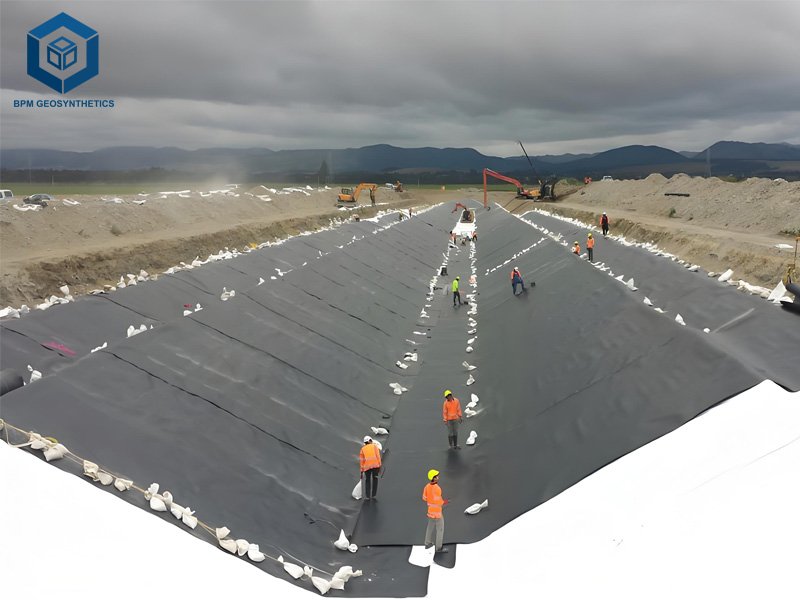
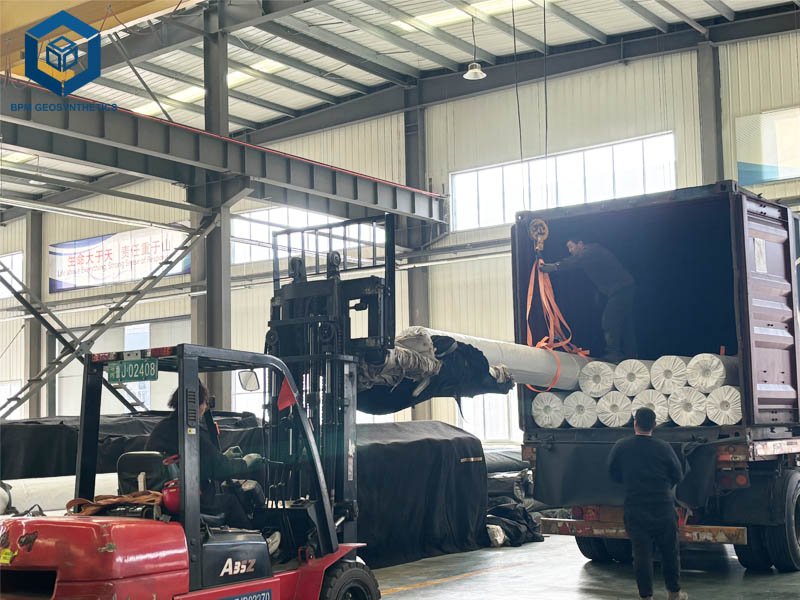
4. Choosing Between LLDPE and PVC Geomembrane
The choice between LLDPE and PVC geomembranes is not a matter of one being inherently “better” than the other. Instead, it is a complex engineering decision that requires a thorough evaluation of project-specific factors. Let’s summarize the key considerations to guide your choice:
| Factor | LLDPE Geomembrane | PVC Geomembrane | Guiding Principle |
| Flexibility / Elongation | Excellent (700-1000% elongation) | Good (220-380% elongation) | Choose LLDPE for projects with anticipated differential settlement, irregular subgrades, or seismic activity. |
| Puncture Resistance | Excellent (370-500 N) | Very Good (can exceed PE at thinner gauges) | Choose LLDPE for robustness against subgrade stresses; PVC for unique stress distribution. |
| Tear Resistance | Superior (approx. 150 N) | Good (approx. 40 N/mm) | Choose LLDPE where high tear resistance is paramount, especially during installation or from sharp objects. |
| Chemical Resistance | Excellent for acids, bases, salts; caution with some hydrocarbons. | Excellent for acids, bases, salts; poor for organic solvents/hydrocarbons (plasticizer leach). | Verify specific chemical compatibility with manufacturer; LLDPE generally safer for hydrocarbons. |
| UV Resistance | Good (when properly formulated with carbon black). | Limited (plasticizer migration, best buried). | Choose LLDPE for exposed applications; PVC requires covering for long-term outdoor exposure. |
| Installation Ease | Very Easy (flexible, fewer wrinkles). | Easy (flexible, good for complex shapes, large prefab panels). | Both are easy to install, but PVC’s large factory panels can significantly reduce field seaming. |
| Seaming Methods | Thermal Fusion (Hot Wedge, Extrusion). | Solvent, Hot Air, Dielectric, Extrusion. | PVC offers more diverse seaming options. |
| Long-Term Durability | Excellent (resistance to stress cracking, UV). | Good, but concerns with plasticizer migration over time, especially if exposed. | LLDPE generally offers superior long-term performance in exposed or hydrocarbon-contact applications. |
| Cost | Comparable to higher initial material; lower overall project cost due to installation. | Often lower initial material; potentially lower overall project cost with large prefab panels. | Evaluate total installed cost and lifespan; consider long-term replacement cycles. |
| Environmental Concerns | More easily recyclable. | Plasticizer leach, more challenging recycling. | LLDPE is generally preferred for environmental sustainability. |
| Density | Lower (0.915-0.925 g/cm³) | Higher (1.25-1.35 g/cm³) | Impacts weight per roll and handling. |
When to Choose LLDPE:
- Dynamic Subgrades:Projects with anticipated differential settlement, seismic activity, or highly irregular terrain.
- Exposed Applications:Liners for canals, exposed ponds, or caps where UV resistance is paramount.
- Aggressive Chemical Environments:Especially where hydrocarbons or organic solvents might be present, after careful compatibility testing.
- High Puncture/Tear Risk:Sites with rocky subgrades or potential for impact during operation.
- Long-Term Performance:For projects requiring a very long design life without concerns about plasticizer loss.
When to Choose PVC:
- Complex Geometries:Projects with intricate shapes, corners, or steep slopes where extreme drapability is beneficial.
- Buried Applications:Ideal when the geomembrane will be consistently covered by soil or other protective layers, mitigating UV and extreme temperature effects on plasticizer.
- Factory Prefabrication:When the project size allows for large, custom factory panels, significantly reducing field work and quality control challenges.
- Non-Aggressive Water Containment:For decorative ponds, agricultural ponds, or water features not involving aggressive chemicals.
- Budget-Sensitive Projects (Initial Cost):Where initial material cost is a primary driver and long-term exposure or specific chemical contact is not a concern.
5. Conclusion
The distinction between LLDPE and PVC Geomembrane is not merely academic; it is fundamental to the successful design and execution of any containment project. LLDPE stands out for its exceptional flexibility, elongation, and resistance to stress cracking and UV degradation, making it ideal for challenging, dynamic, and exposed applications. Its robust mechanical properties ensure long-term integrity in demanding environments. Conversely, PVC offers remarkable initial flexibility and ease of fabrication into large panels, which can be highly advantageous for certain buried applications and intricate designs where initial cost and rapid deployment are key.
However, the critical consideration for PVC remains plasticizer migration, which limits its suitability for long-term exposed applications or those involving contact with hydrocarbons. By carefully evaluating the specific environmental conditions, chemical exposure risks, anticipated ground movements, and required lifespan of a project, engineers and project managers can leverage the detailed properties and data presented in this guide to make an informed, data-driven decision. The ultimate goal is to select a geomembrane that not only meets the immediate project specifications but also ensures durable, reliable, and sustainable containment for decades to come, allowing the data to speak for itself in safeguarding our environment and infrastructure.If you have any questions about the project, please consult BPM Geomembrane.

